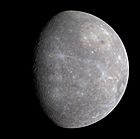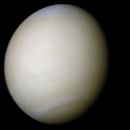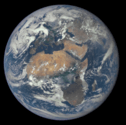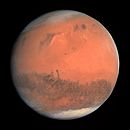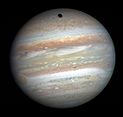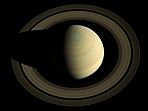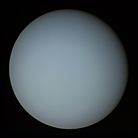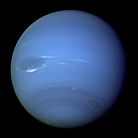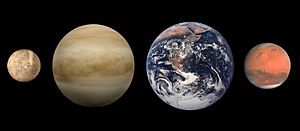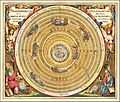Planet facts for kids
|
||||
The eight known planets of the Solar System
Shown in order from the Sun and in true color. Sizes are not to scale. |
A planet is a huge space object, like Jupiter or Earth. It travels around a star in a path called an orbit. Planets are smaller than stars and do not make their own light.
Planets are shaped like a slightly squashed ball, which is called a spheroid. Smaller objects that orbit planets are known as satellites or moons. A star and everything that orbits it make up a star system.
Our own Solar System has eight planets. For a long time, Pluto was considered a planet. But in 2006, scientists decided it was a dwarf planet instead. There are four other known dwarf planets in our Solar System: Ceres, Makemake, Eris, and Haumea.
The word "planet" comes from the Greek word planetes. This means "wanderers" or "things that move." Before the 1990s, people only knew about the planets in our Solar System. But by 2011, we had found over 500 other planets! These new planets orbit stars other than our Sun. They are called extrasolar planets or "exoplanets."
Contents
Planets in Our Solar System
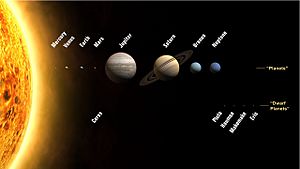
The planets in our Solar System are named after Greek or Roman gods. Earth is the only exception. This is because people in ancient times did not think Earth was a planet. Sometimes, Earth is called Terra, which is a Roman name. Other languages, like Chinese, use different names for the planets. Moons are also named after gods, people from mythology, or characters from Shakespeare's plays.
Our Solar System's Planets
Here is a list of the planets in our Solar System. They are listed by how close they are to the Sun, starting with the closest one.
| Planet | Symbol |
|---|---|
| Mercury | |
| Venus | |
| Earth | |
| Mars | |
| Jupiter | |
| Saturn | |
| Uranus | |
| Neptune |
How Planets Got Their Names
The names for the planets in our Solar System come from ancient naming traditions. These traditions were developed by the Babylonians, Greeks, and Romans. They often named planets after their gods.
In ancient Greece, the Sun was called Helios and the Moon was Selene. The slowest planet, Saturn, was called Phainon. Jupiter was Phaethon, and Mars was Pyroeis (the "fiery" one). The brightest planet, Venus, was Phosphoros (the light bringer). Mercury, which moved quickly, was called Stilbon.
The Greeks connected each planet to one of their gods:
- Phainon (Saturn) was linked to Cronus, the father of the gods.
- Phaethon (Jupiter) was linked to Zeus, who became king of the gods.
- Pyroeis (Mars) was linked to Ares, the god of war.
- Phosphoros (Venus) was linked to Aphrodite, the goddess of love.
- Stilbon (Mercury) was linked to Hermes, the messenger god.

When the Romans learned about Greek astronomy, they used the names of their own gods for the planets. So, Hermes became Mercurius, Aphrodite became Venus, Ares became Mars, Zeus became Iuppiter, and Cronus became Saturnus.
This naming system also influenced the names of the days of the week. The Romans believed that seven gods, after whom the planets were named, took turns looking after Earth. Each day was named after the god who started its shift. This is why we have Saturday (Saturn's day), Sunday (Sun's day), and Monday (Moon's day). Other days were later renamed after Anglo-Saxon gods who were similar to the Roman gods. For example, Tuesday is named after Tīw (like Mars), Wednesday after Wōden (like Mercury), Thursday after Þunor (like Jupiter), and Friday after Frīġ (like Venus).
The name "Earth" in English does not come from Greek or Roman mythology. It comes from the Old English word eorþe, meaning "ground" or "dirt." This is because Earth was not seen as a planet until the 17th century. Many other languages use words for "ground" or "land" for Earth, like the Roman word terra.
When Uranus and Neptune were discovered later, they were also named after Greek and Roman gods. Pluto was given a classical name too, when it was first found.
Types of Planets
Scientists talk about "major" or "true" planets, and "minor planets." Minor planets are smaller objects that orbit the Sun. Examples of minor planets include asteroids and comets.
Planets in our Solar System can be grouped into three main types:
- Terrestrial or rocky planets: These planets are mostly made of rock. They are similar to Earth. This group includes Mercury, Venus, Earth, and Mars.
- Jovian or gas giants: These planets are mostly made of gas. Jupiter, Saturn, Uranus, and Neptune are gas giants. Uranus and Neptune are sometimes called "ice giants" because they have more hydrogen and helium than Jupiter and Saturn.
- Icy planets: Sometimes, people also talk about a third type for objects like Pluto. These planets are mostly made of ice. Many other icy objects in the Solar System are not planets, such as the icy moons of the outer planets, like Triton.
Related pages
Images for kids
-
Earth's axial tilt is about 23.4°. It oscillates between 22.1° and 24.5° on a 41,000-year cycle and is currently decreasing.
-
The rings of Saturn
See also
 In Spanish: Planeta para niños
In Spanish: Planeta para niños


